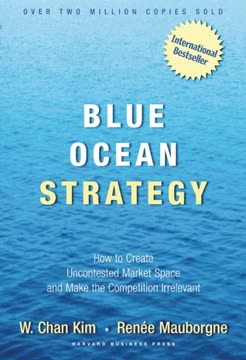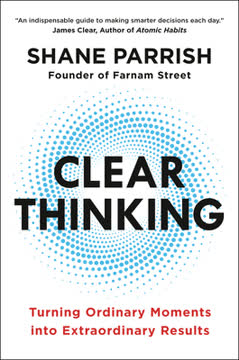つの重要なポイント
1. 効果的な問題解決には、一般的な落とし穴を避けるための構造化されたアプローチが必要
「見る方法は、見ない方法でもある。」
バイアスや罠を避ける。 問題解決は認知バイアスや落とし穴に陥りやすく、効果的な解決策を見つけるのが難しくなる。一般的な罠には以下のものがある:
- 問題の定義の誤り:核心的な問題を誤認する
- 解決策の確認:先入観に基づいた解決策を支持する証拠を探す
- 間違ったフレームワーク:不適切なメンタルモデルや分析ツールを適用する
- 狭いフレーミング:潜在的な解決策の範囲を制限する
- 誤ったコミュニケーション:解決策を効果的に伝えられない
これらの落とし穴を克服するためには、問題解決者は仮定を疑い、複数の視点を考慮し、潜在的な解決策を厳密にテストする構造化されたアプローチを採用する必要がある。
2. 包括的な問題解決のための4Sメソッド:State、Structure、Solve、Sell
「大きな問題を解決し、トップ戦略コンサルタントのように解決策を売るためには、規律ある汎用的な問題解決メソッドと、プロセスの各ステップに役立つツールが必要です。」
4Sフレームワークをマスターする。 4Sメソッドは包括的な問題解決アプローチを提供する:
- State:問題を正確に定義する
- Structure:問題を管理可能なコンポーネントに分解する
- Solve:分析し、解決策を開発する
- Sell:解決策を伝え、関係者を説得する
このメソッドは分析的思考と創造的思考を統合し、問題空間と潜在的な解決策を徹底的に探求することを保証する。これらのステップに従うことで、問題解決者は複雑な課題を体系的にナビゲートし、効果的で実行可能な解決策を開発できる。
3. 問題を正確に定義することが正しい解決策を見つけるために重要
「よく定義された問題は半分解決されたも同然。」
TOSCAを使って明確にする。 問題を正確に定義することは、正しい解決策を見つけるための基本である。TOSCAフレームワークは問題の定義を助ける:
- Trouble:この問題が現実であることを示すものは何か?
- Owner:この問題の所有者は誰か?
- Success criteria:成功とはどのようなもので、いつ達成されるのか?
- Constraints:解決策の範囲に対する制約は何か?
- Actors:この問題を解決する方法に関与する人は誰か?
これらの要素に対処することで、問題解決者は明確で実行可能な問題定義を作成し、その後の分析と解決策の開発を導くことができる。このステップは、誤った問題を解決したり、症状に対処するだけで根本原因を見逃すという一般的な落とし穴を避けるために重要である。
4. 仮説ピラミッドやイシューツリーを使って問題を構造化する
「フレームワークはビジネス推論の働き者である。」
適切な構造化ツールを選ぶ。 複雑な問題を構造化することは、効果的な分析と解決策の開発に不可欠である。主なアプローチは以下の2つ:
-
仮説ピラミッド:
- 潜在的な解決策から始め、それを支持する仮説に分解する
- 強力な候補解決策をテストする場合に有用
- 注意しないと確認バイアスのリスクがある
-
イシューツリー:
- 解決策を仮定せずに問題を構成要素に分解する
- よりオープンエンドでバイアスに陥りにくい
- 包括的に開発するにはより多くの努力が必要
どちらのアプローチもMECE(相互排他的かつ包括的)な分解を目指すべきである。適切な構造化ツールの選択は、問題の性質と潜在的な解決策に対する確信のレベルに依存する。
5. 複雑な問題の解決にはデザイン思考と共感が必要な場合がある
「共感はデザイン思考の基盤である。」
人間中心のデザインを受け入れる。 複雑で定義が難しい問題に対しては、従来の分析的アプローチが不十分な場合がある。デザイン思考は代替の道を提供する:
- 共感:ユーザーのニーズと経験を理解する
- 定義:洞察を統合して問題をフレーム化する
- 発想:多様な解決策のコンセプトを生成する
- プロトタイプ:アイデアの具体的な表現を作成する
- テスト:フィードバックを収集し、解決策を洗練する
このアプローチは特に以下のような問題に効果的である:
- 人間中心
- 複雑で不確実
- 正確に定義するのが難しい
- 従来の分析方法に抵抗する
共感と反復的な解決策の開発に焦点を当てることで、デザイン思考はユーザーのニーズにより効果的に対応する革新的な解決策を見つけることができる。
6. 反復プロセスを通じて革新的な解決策を生成、プロトタイプ、テストする
「頻繁に失敗することで、早く成功する。」
実験を受け入れる。 革新的な問題解決には、複数の潜在的な解決策を生成し、迅速にテストすることが必要である。主要な原則には以下が含まれる:
- 発散的思考:判断せずに多様なアイデアを生成する
- 迅速なプロトタイピング:低忠実度の解決策の表現を迅速に作成する
- 反復的なテスト:ユーザーフィードバックを収集し、解決策を継続的に洗練する
アイデア生成の技法:
- アナロジカルシンキング
- ブレインストーミングとブレインライティング
- SCAMPER(代替、結合、適応、修正、他の用途に使用、排除、逆転)
反復的で実験的なアプローチを受け入れることで、問題解決者は純粋に分析的な方法では明らかにならなかった解決策を発見し、洗練することができる。
7. 説得力のあるストーリーラインとプレゼンテーションで解決策を効果的に売り込む
「探索のストーリーを語ることは、解決策のストーリーを語ることとは異なる。」
説得力のあるナラティブを作成する。 効果的な解決策を開発することは半分の戦いに過ぎない。関係者にそれを採用させる必要がある。解決策を売り込むための主要な原則には以下が含まれる:
-
ピラミッド原則を使用する:
- コアメッセージ(統治思想)から始める
- 主要なラインアーギュメントでサポートする
- 詳細な支持証拠を提供する
-
グルーピングとアーギュメント構造を選択する:
- グルーピング:コアメッセージを支持する並列の理由を提示する
- アーギュメント:結論に至る論理的なシーケンスを構築する
-
モジュラーなプレゼンテーションを開発する:
- エグゼクティブサマリーを作成する
- セクションを紹介するストーリーページを使用する
- 明確で行動指向のタイトルを持つコンテンツページをデザインする
-
データを効果的に視覚化する:
- 異なる分析に適したチャートタイプを使用する
- チャートをシンプルにし、キーメッセージに焦点を当てる
明確で説得力のあるストーリーラインを作成し、それをよくデザインされたビジュアルエイドでサポートすることで、解決策を効果的に伝え、関係者の賛同を得ることができる。
最終更新日:
FAQ
What's Cracked It! about?
- Problem-Solving Focus: Cracked It! by Bernard Garrette is centered on teaching readers how to solve complex business problems effectively, similar to top strategy consultants.
- 4S Methodology: It introduces the 4S method, which includes four stages: State, Structure, Solve, and Sell, providing a structured approach to problem-solving.
- Real-World Applications: The book uses real-life case studies to illustrate these concepts, making it practical for business leaders and aspiring consultants.
Why should I read Cracked It!?
- Enhance Problem-Solving Skills: The book offers valuable frameworks and techniques to improve your ability to tackle complex business challenges.
- Learn from Experts: Written by Bernard Garrette, Corey Phelps, and Olivier Sibony, the authors bring extensive academic and consulting experience.
- Avoid Common Pitfalls: It helps readers identify and avoid common pitfalls in problem-solving, such as flawed problem definitions and confirmation bias.
What are the key takeaways of Cracked It!?
- Structured Approach: The 4S method emphasizes the importance of a disciplined process in problem-solving.
- TOSCA Framework: This framework is essential for clearly defining problems before attempting to solve them.
- Importance of Communication: Effectively selling your solution is as crucial as solving the problem itself, integrating communication into the problem-solving process.
What is the 4S method in Cracked It!?
- Four Stages: The 4S method consists of State (define the problem), Structure (organize the problem), Solve (analyze and find solutions), and Sell (communicate the solution).
- Iterative Process: It emphasizes that the process is iterative, allowing for revisiting and refining each stage as new insights are gained.
- Flexibility in Application: The method can be adapted to various contexts, making it versatile for different types of business problems.
How does the TOSCA framework work in Cracked It!?
- Five Elements: TOSCA stands for Trouble, Owner, Success criteria, Constraints, and Actors, guiding problem definition.
- Guides Problem Definition: This framework helps in formulating a clear and actionable problem statement, ensuring all critical aspects are considered.
- Iterative Refinement: Encourages revisiting and refining the problem statement as new information is gathered.
What are the five pitfalls of problem-solving discussed in Cracked It!?
- Flawed Problem Definition: Misdefining the problem can lead to irrelevant solutions.
- Solution Confirmation: Occurs when solvers only seek evidence supporting their initial hypotheses.
- Wrong Framework: Using an inappropriate framework can lead to ineffective solutions.
- Narrow Framing: Oversimplifying complex problems can result in overlooking viable solutions.
- Miscommunication: Poorly communicating solutions can lead to inaction, even if the solution is sound.
What is the difference between hypothesis-driven and issue-driven problem structuring in Cracked It!?
- Hypothesis-Driven: Starts with a candidate solution and tests it, which can lead to confirmation bias if not managed carefully.
- Issue-Driven: Involves breaking down the problem into smaller, MECE components without preconceived solutions.
- Use Cases: Hypothesis-driven is efficient with strong confidence in the hypothesis, while issue-driven is preferred for complex problems.
How can I apply the 4S method in my organization according to Cracked It!?
- Start with State: Begin by clearly defining the problem using the TOSCA framework.
- Structure the Problem: Use a hypothesis pyramid or an issue tree to organize the problem logically.
- Conduct Analyses: Perform analyses to test hypotheses or answer questions in your issue tree.
- Sell the Solution: Communicate findings and recommendations effectively, focusing on audience needs.
How does Cracked It! incorporate design thinking?
- Human-Centered Approach: Emphasizes empathy in problem-solving, aligning with design thinking principles.
- Iterative Process: Design thinking involves phases of empathizing, defining, ideating, prototyping, and testing.
- Real-World Applications: Provides examples of successful design thinking applications, encouraging a creative mindset.
What are some best practices for selling solutions as described in Cracked It!?
- Clear Core Message: Start with a clear core message when presenting solutions.
- Use of the Pyramid Principle: Structure presentations with a logical flow to persuade the audience effectively.
- Engaging the Audience: Use storytelling and interactive discussions to foster a collaborative environment.
What are some analytical frameworks mentioned in Cracked It!?
- Industry Frameworks: Analyze value drivers specific to an industry, such as the Five Forces model.
- Functional Frameworks: Versatile tools applicable across various business contexts, like market segmentation.
- Logical Decompositions: Use logical reasoning to break down problems into manageable components when frameworks are unavailable.
What are the best quotes from Cracked It! and what do they mean?
- “Good analysis is the heart of good problem solving.”: Emphasizes the importance of thorough analysis in developing effective solutions.
- “Prototyping is a highly iterative process.”: Encourages continuous refinement of ideas through prototyping.
- “The ultimate objective of solution selling isn’t to gain intellectual support for your solution, but to trigger action.”: Highlights the importance of clear communication and persuasive storytelling to motivate decision-makers.
レビュー
本書『Cracked it!』は、問題解決に対する包括的なアプローチで読者から高い評価を受けている。レビューでは、体系的な4Sメソッド、実際の事例、実践的なフレームワークが評価されている。多くの読者は、これが新進のコンサルタントや経験豊富なコンサルタント、マネージャー、問題解決者にとって非常に価値があると感じている。本書は理論と実践のバランス、明確な文体、TOSCAフレームワークやピラミッド原則といった有用なツールで称賛されている。一部の読者は学術的なトーンを指摘するが、それでも問題解決スキルの向上に非常に役立つと感じている。
Similar Books














